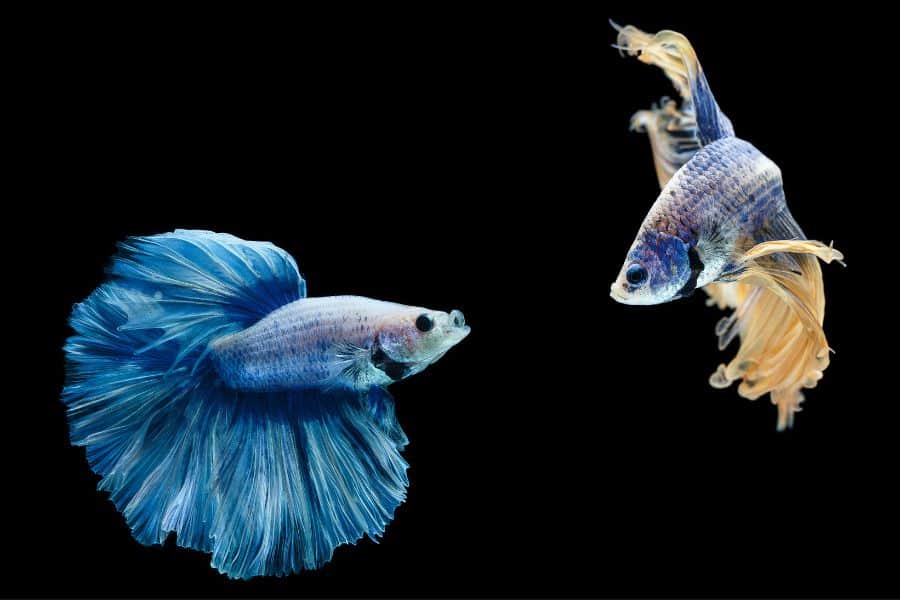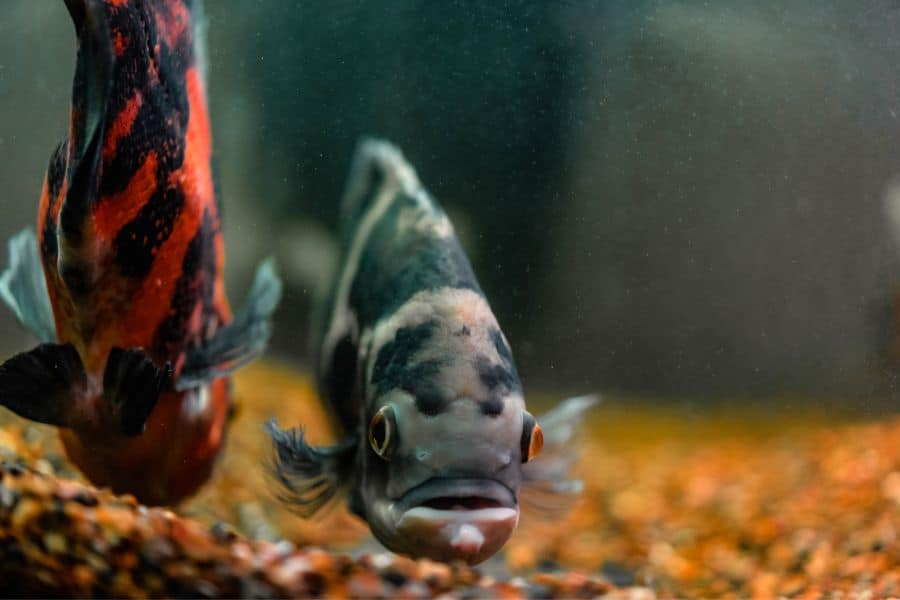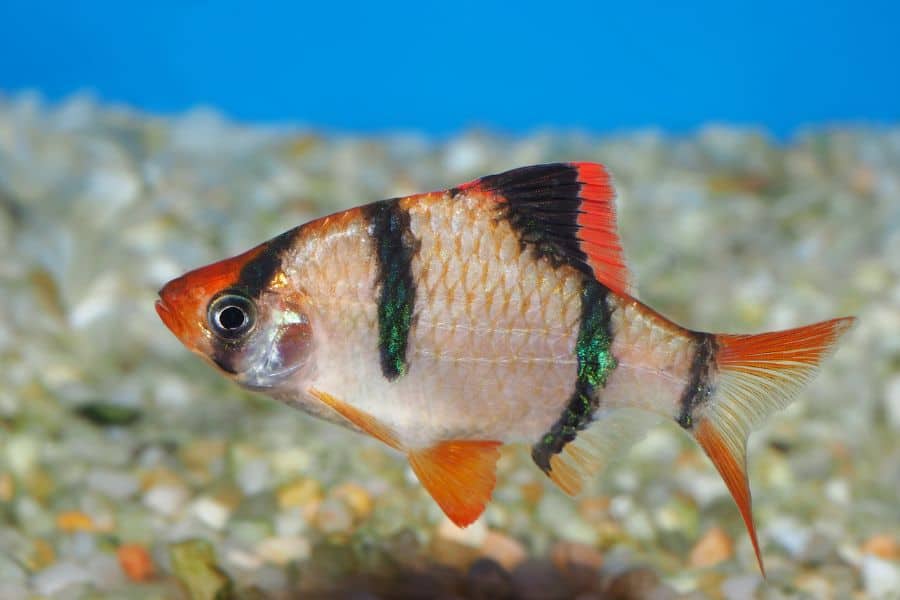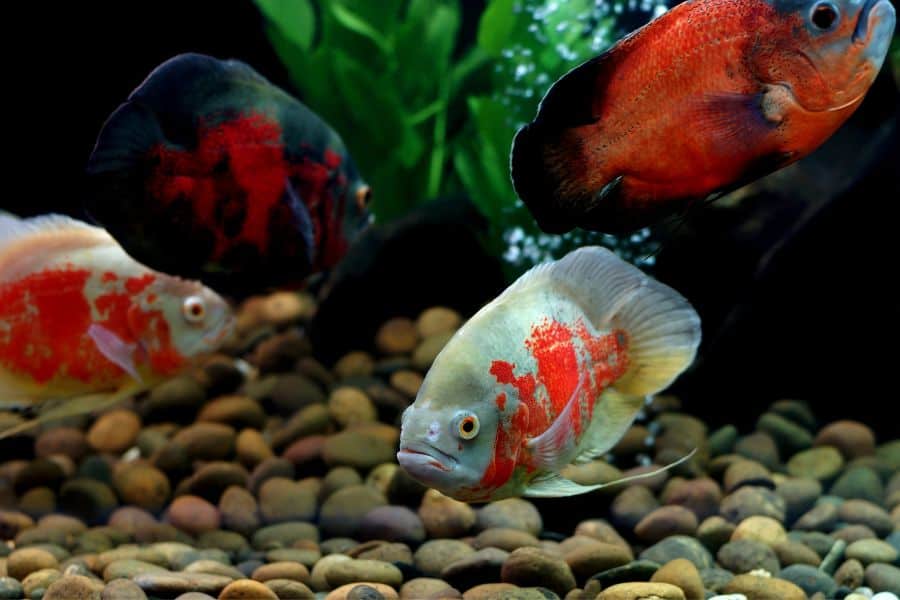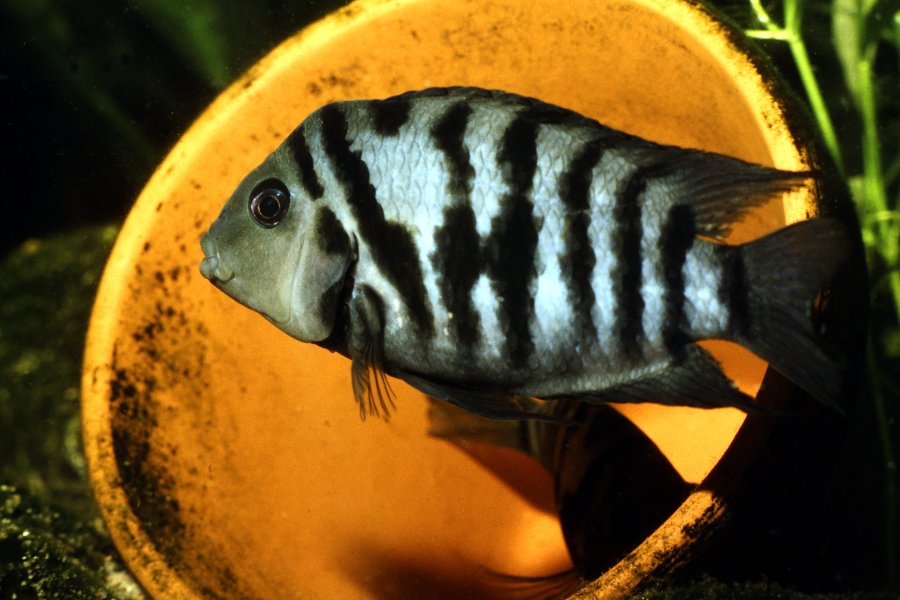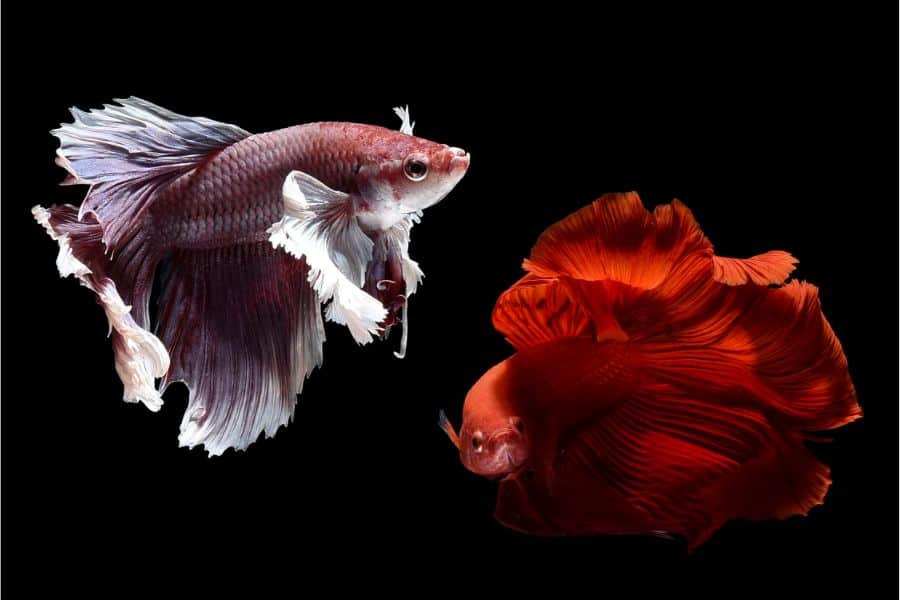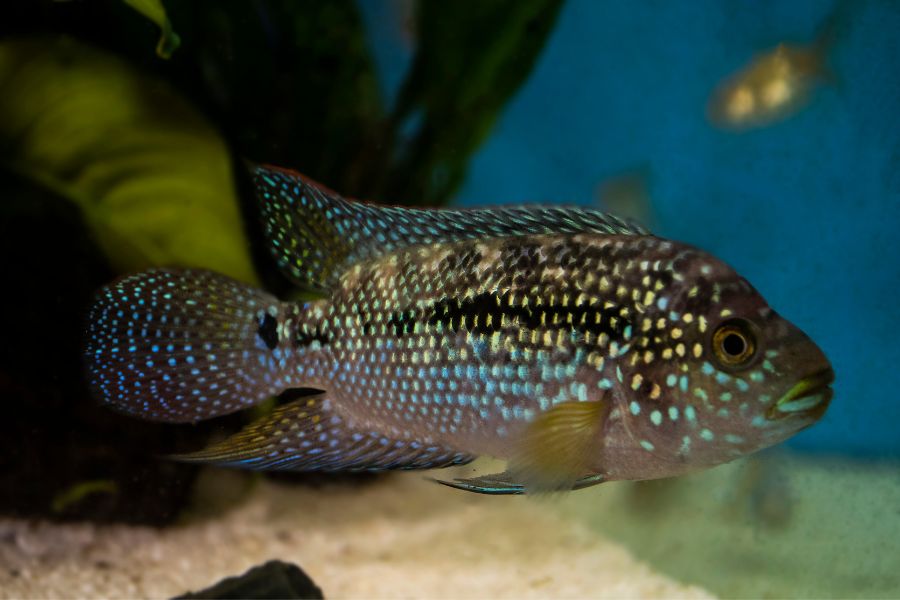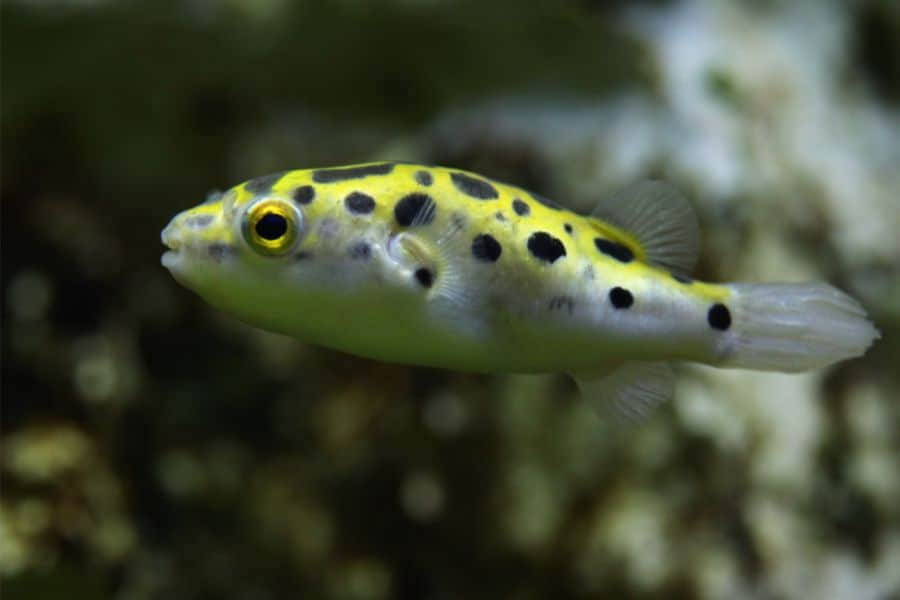Many popular aquarium fish are very aggressive, including the tetras, Oscars, cichlids, and Jack Dempsey. Mixing these types of fish with incompatible peaceful species is among the leading causes of death in aquariums, which makes it ever so important to learn how to spot an aggressive species from a mile away.
Aggression in aquarium fish is primarily motivated by the defense of valuable resources. Fish tend to exhibit increased aggression when resources are scarce or in high demand. This explains why fish are more likely to behave aggressively in overstocked aquariums.
So, if you are looking for signs of aggression in fish, then a good place to start is to take a look at the distribution of resources in the tank, such as potential mates, territory, or food.
Read on to know the tale tell signs of aggressive fish, what to do about them, and the top most aggressive fish in the aquarium trade to watch.
How to Spot Aggressive Fish In Aquariums: Signs & Behaviors
It can be hard to tell if your aquarium fish are playing or fighting with each other. Beginners have a hard time differentiating the two, particularly when one species is chasing the other.
Fish chase each other all the time as part of their natural behavior, and it is how they interact with one another. However, a chase can also mean that a fish is territorial and does not want to share their space. With that in mind, keep in mind these signs of aggression in your fish to tell which is which:
1. Physical Trauma
This is a clear sign of aggression from another fish. If a particular species is often getting hurt with visible signs of trauma, including marks on its body and nips on the fins, then you have an aggressive species in the tank.
Keep an eye on the injured fish; if it runs away or hides from another species in the tank, then you already know who the culprit is. Look for signs of scratches, scrapes, wounds, and missing scales.
Good examples of fishes that exhibit this sort of aggression include the barbs, tetras, and cichlids. These aggressive fish tend to attack and damage the fins of other fish, so if you notice torn or ragged fins, it could be a sign of their aggression.
2. Stress & Bullying
If a fish is constantly hiding, not eating, or seems stressed, it could be due to aggression from other fish in the tank. Stress in fish increases if they are sick, the tank has poor water conditions, and food is scarce.
These conditions not only stress the fish but also increase the aggression in certain species, causing them to lash out more, become more territorial, and swim erratically.
If a fish constantly pushes other fish around or prevents them from accessing food or hiding spots, it could display aggressive bullying behavior.
3. Same-Sex Territorial Behavior
Territorial aggression is the biggest problem of aggressive fish in an aquarium. The problem is larger when you have a larger-than-average type of fish.
Same-sex territorial behaviors, particularly among males, are common in many species that are known for being aggressive, including the tetras and cichlids. These behaviors are largely amplified in certain conditions like smaller tanks when you have poor water quality or little presence of hiding spots.
These aggressive fish show their aggression in different ways depending on the species. A common theme in territorial fish is biting and attacking other fish who enter their territories. They also chase other fish around the tank to lay claim to territories.
Gouramis, for example, are known to vocalize their territories by making sounds and vibrations to warn other fish to stay away. Cichlids, on the other hand, can build nests and other structures in their areas of dominance to attract female mates and deter any male fish from entering.
Some fish may display their dominance by flaring their fins or other physical displays. For example, male Betta fish will often flare their gills and fins to intimidate other males and establish dominance.
All of these behaviors are meant to protect the fish’s breeding grounds by deterring competition and attracting more mates to breed with.
Female fish are more territorial when protecting their eggs and fry in a maternal or parental manner. However, they can also display a lot of aggression when there are two dominant females trying to choose the same male for mating.
4. Fish That Eats Other Fish
Aggressive fish that eat other fish have clear signs of predatory behaviors in the way they hunt other fish and chase them throughout the tank. Some common examples of fish that eat other fish include the red devil cichlids, Jack Dempsey, Angelfish, Oscar, and Green Spotted Puffer.
Freshwater predator fish are the most aggressive in any aquarium and should never be kept next to fish they frequently prey on in the wild. They thrive in same-species tanks and alongside similar-sized fish.
It is also crucial to note that fish are opportunistic creatures. This means that they can eat other fish just because they are a source of food available in the tank.
Aquarists reduce this behavior by ensuring the fish is well-fed and less stressed. If you do not feed your fish properly, they will start looking for food sources elsewhere.
New fish are more prone to this problem because they have not yet adjusted to the conditions in the tank. They hunt more and are also hunted more by those fish in the tank with already established territories.
5. Fish Chasing Other Fish
As stated earlier, chasing can mean different things. But a good way to know if a chasing fish is aggressive is to see how they interact with the other fish when the chase is done.
Like dogs, fish play with each other in the most confusing and vicious ways, but once they are done, they lay next to each other, relax, and stare at the beauty in their environment together. That is when they are being playful.
If an aggressive fish is chasing another fish, then you will notice more intense aggression on the part of the aggressor. There will be some injuries, violent swimming stances, and louder noises from the tank.
It is also harder to notice this type of aggression because it often happens when you are not looking; it may almost seem like they are trying to hide it from you.
How To Deal With Aggressive Fish In An Aquarium: 3 Simple Methods
Now that you can tell which fish are aggressive, what should you do about it? Should you remove the aggressive fish from your tank? The short answer is NO.
There are a couple of tips and tricks that you can use to reduce the aggression of your fish or ensure they do not act on their innate aggressive side.
When applying any of these solutions, keep in mind that any form of aggression in aquarium fish is primarily motivated by the defense of valuable resources, such as potential mates, territory, or food.
Any solutions that help reduce competition for resources will inevitably reduce the aggression rate in your fish. Below are the best of such solutions:
1. Increase Tank Size & Complexity
According to a study from Case Western Reserve University, it was discovered that an increase in tank size & complexity was the number one most efficient way of reducing harmful aggressive behaviors in fish.
The study compared the behavior of Midas cichlids in their natural habitat, in large artificial streams, and in small tanks. It was found that an increase in tank size and complexity, such as the addition of obstacles and hiding places, can reduce harmful aggressive behaviors and make for healthier fish.
Providing fish with a larger tank can help reduce aggression by giving them more space to establish territories and explore without feeling threatened by other fish.
Also, maintaining a balanced population of fish can help reduce aggression by preventing overcrowding and competition for resources. Overcrowding can lead to stress and aggression, while a balanced population allows each fish to have enough space and resources to thrive.
Adding hiding spots, such as plants, rocks, and other decorations, can help reduce aggression by giving fish a place to retreat when they feel threatened or stressed. This can also help establish multiple territories in the tank, reducing the likelihood of aggressive confrontations.
A bigger tank also means better water quality. Poor water quality can lead to stress which inevitably leads to increased aggression.
2. Compatible Tank Mates
Having compatible tank mates can reduce aggression in fish as it decreases the competition for resources such as food and territory.
Additionally, having tank mates of similar size, temperament, and feeding habits can prevent conflicts and promote a more peaceful environment in the aquarium. Researching and carefully selecting compatible species when setting up a community tank is important to avoid aggression and potential harm to the fish.
3. Keep Water Conditions & Temperature Optimal
A select group of aggressive fish (like the African cichlids) temporarily become more aggressive when temperatures are increased. This is due to increased metabolism and energy requirements, which strain resources. Always strive to maintain your species’ ideal temperatures.
Good water conditions in an aquarium can reduce aggression in fish by keeping them stress-free. Poor water quality can cause stress by affecting their immune system, gills, and overall health. When fish are kept in good-quality water with the proper pH, temperature, and chemical balance, they are less likely to become stressed and aggressive.
Additionally, a well-aerated and well-filtered aquarium with regular water changes can help to reduce the build-up of harmful toxins that can contribute to aggressive behavior in fish.
Top 10 Most Common Aggressive Fish For Aquariums
Now that you know how to spot and deal with aggressive fish, you must be wondering what the most aggressive fish for an aquarium is. Here are the top common aquarium choices:
1. Tiger Barb – Semi Aggressive
| Common Names | Sumatra barb |
| Scientific Name | Puntigrus tetrazona or Barbus tetrazona |
| Average Size | 3 inches |
| Lifespan | Up to 6 years |
| Minimum Tank Size | 20 gallons |
| Ideal Temperatures | 68-72 degrees Fahrenheit |
| Ideal pH Levels | 6.0 – 7.0 |
The tiger barbs are slightly aggressive, showing their aggression through nipping and chasing smaller-sized fish. Semi-aggressive types of fish are very common in aquariums and also include the likes of red tail sharks, rainbow sharks, and jewel cichlids.
Like other common semi-aggressive fish, the tiger barb mostly shows aggression among its own species and when it is heavily stressed in its environment. It attacks only when it feels threatened and when resources such as food and territory are limited.
Keep tiger barbs in groups of six or more to help diffuse their aggression and provide them with a sense of security in their environment.
2. Oscars – Semi-Aggressive
| Common Names | Tiger Oscar, marble cichlid, velvet cichlid |
| Scientific Name | Astinotus ocellatus |
| Average Size | Up to 10-18 inches |
| Lifespan | Up to 15 years |
| Minimum Tank Size | 55 gallons |
| Ideal Temperatures | 72 – 82 degrees Fahrenheit |
| Ideal pH Levels | 6.0 – 7.0 |
Oscars are part of the cichlids family, which is popularly known for its aggressive array of fish. However, it is still ranked among semi-aggressive aquarium fish since their aggression is often territorial rather than predatorial or bullying.
They tend to nip at the fins of other fish, and they may even attack and kill smaller fish if they feel threatened or if they perceive them as competition for food or territory.
Do not place them near other fish they can eat, especially during their breeding season. There are more protective of their eggs and fry to the extent of killing other fish that come near their young ones.
3. Convict Cichlids – Extremely Aggressive
| Common Names | Zebra cichlids |
| Scientific Name | Amatitlania nigrofasciata |
| Average Size | 3 – 6 inches |
| Lifespan | Up to 10 years |
| Minimum Tank Size | 30 gallons |
| Ideal Temperatures | 66 -78 degrees Fahrenheit |
| Ideal pH Levels | 6.5 – 8.0 |
Convict cichlids are highly aggressive fish that have been known to even pick fights with larger fish. They are very territorial and will eat any smaller fish that happens to wander into their territories. They do well in schools of their own kind also helps reduce their aggression greatly.
When breeding, convict cichlids can become extremely territorial and may attack any other fish that comes too close to their eggs or fry. They will also aggressively defend their chosen breeding site, which can include rocks, caves, or other hiding places in the tank.
Despite their high aggression, convict cichlids are easy to care for, with little maintenance and attendance required.
4. Red Devil Cichlid – Extremely Aggressive
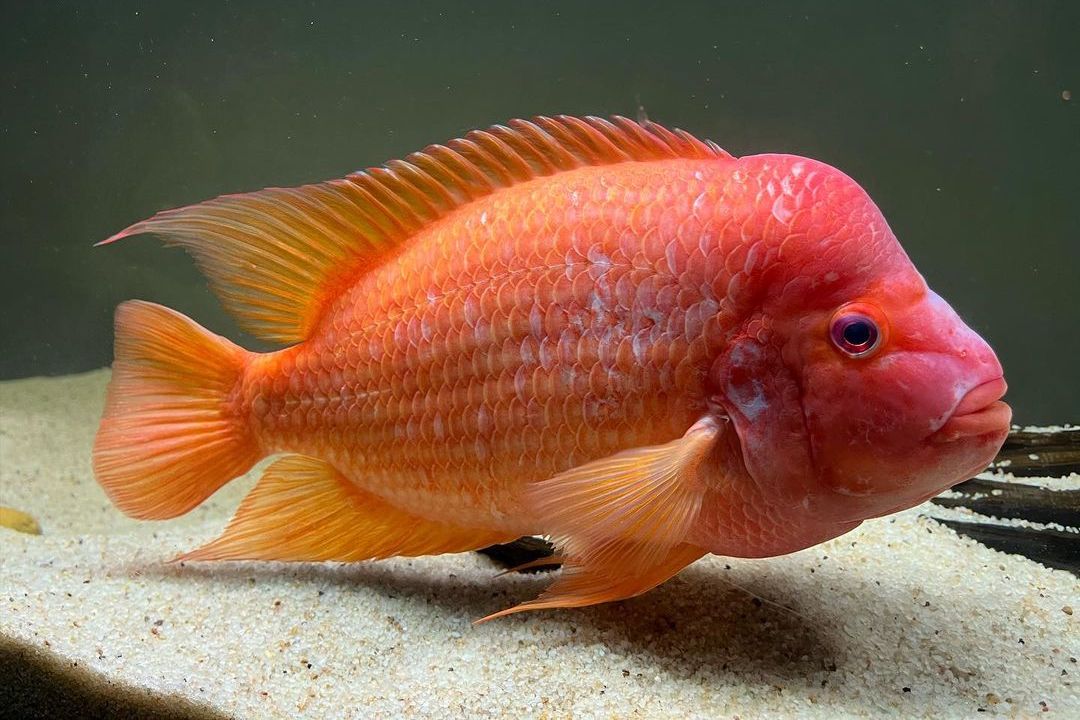
| Scientific Name | Amphilophus labiatus |
| Average Size | Up to 15 inches |
| Lifespan | Up to 12 years |
| Minimum Tank Size | 55 gallons |
| Ideal Temperatures | 72 – 79 degrees Fahrenheit |
| Ideal pH Levels | 6.5 – 7.5 |
Red devil cichlids are very aggressive and hostile to other fish in the tank as well as décor and plants. They are known for destroying anything they can put their mouths on, including uprooting plants, turning over decorations in the aquarium, and eating smaller-sized fish. They are also known for attacking humans too.
Always put the red devil cichlids in their own spacious tank. If you want them to have other species’ tank mates, then start by keeping them together from an early age. Also, ensure there are multiple hiding spots for other fish.
Since red devil cichlids are monogamous, you never have to worry about aggression during the breeding season since they bond and mate for life with little competition.
5. Betta – Extremely Aggressive
| Common Names | Siamese fighting fish |
| Scientific Name | Betta splendens |
| Average Size | 3 inches |
| Lifespan | Up to 3 years |
| Minimum Tank Size | 5 gallons |
| Ideal Temperatures | 75– 82 degrees Fahrenheit |
| Ideal pH Levels | 6.6 – 7.5 |
Did you know that the betta fish were initially bred centuries ago for their aggression and ability to fight in ‘cockfighting’ gambling matches? This tradition continues to this day and is the reason why bettas are also called fighting fish.
Bettas are extremely aggressive and territorial and have been known to kill their own kind in fights over territory. Their aggression comes from over six centuries of artificial selections for fights and gambling businesses.
However, it is important to note that not all bettas are as aggressive. Aggression levels can vary depending on the individual fish and their environment. Providing adequate space and hiding places in the aquarium can help reduce aggression, as can avoiding overcrowding and introducing fish of similar size and temperament.
6. Veil Angelfish – Semi-Aggressive
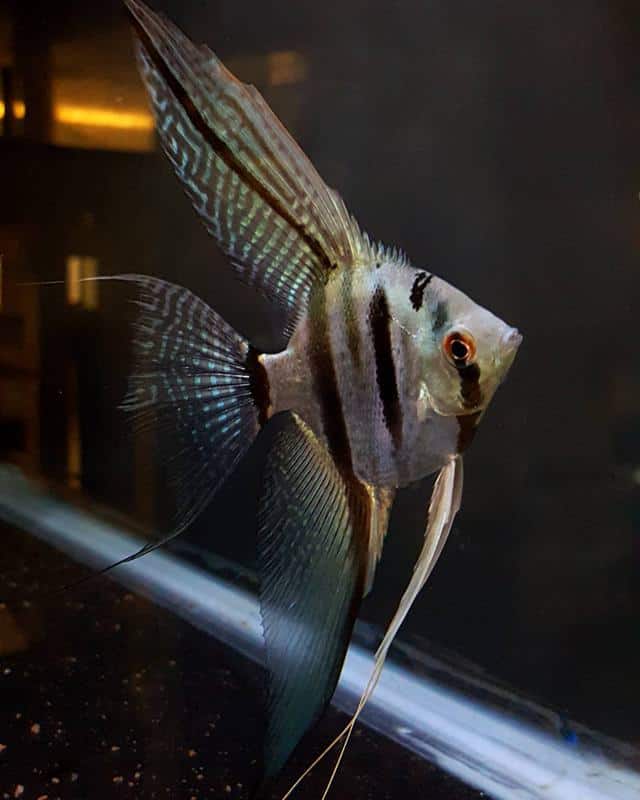
| Scientific Name | Pterophyllum scalare |
| Average Size | 6 inches |
| Lifespan | Up to 4 years |
| Minimum Tank Size | 55 gallons |
| Ideal Temperatures | 72 – 82 degrees Fahrenheit |
| Ideal pH Levels | 6.0 – 7.0 |
All types of Angelfish have a territorial type of aggression that helps them assert dominance and reduce competition. The aggression is more frequent in tanks that have too many males since they will try to kill each other in order to have a higher chance of mating.
In smaller aquariums, the aggression of veil angelfish may be more pronounced due to limited space and resources. This can lead to fights over territory, food, or mates and may result in physical harm to other fish in the tank.
7. Jack Dempsey Cichlid – Extremely Aggressive
| Scientific Name | Cichlasoma octofasciatum |
| Average Size | 8 – 11 inches |
| Lifespan | 8 – 10 years |
| Minimum Tank Size | 55 gallons |
| Ideal Temperatures | 75 – 8.5 degrees Fahrenheit |
| Ideal pH Levels | 7.0 – 8.0 |
Having a complex habitat with plenty of hiding spots, décor, and shelter has been shown to greatly reduce the high aggression in Jack Dempsey, particularly during the breeding and spawning season.
Named after the heavyweight boxer Jack Dempsey, this species’ very definition is aggression, with many examples from fighting during feeding times, bullying smaller-sized fish, nipping at other fish, and chasing any intruders.
To minimize aggression in Jack Dempsey fish, it is recommended to provide plenty of hiding spots and territories in the aquarium, as well as ensure that the aquarium is large enough to accommodate their needs.
8. Bucktooth Tetra – Extremely Aggressive
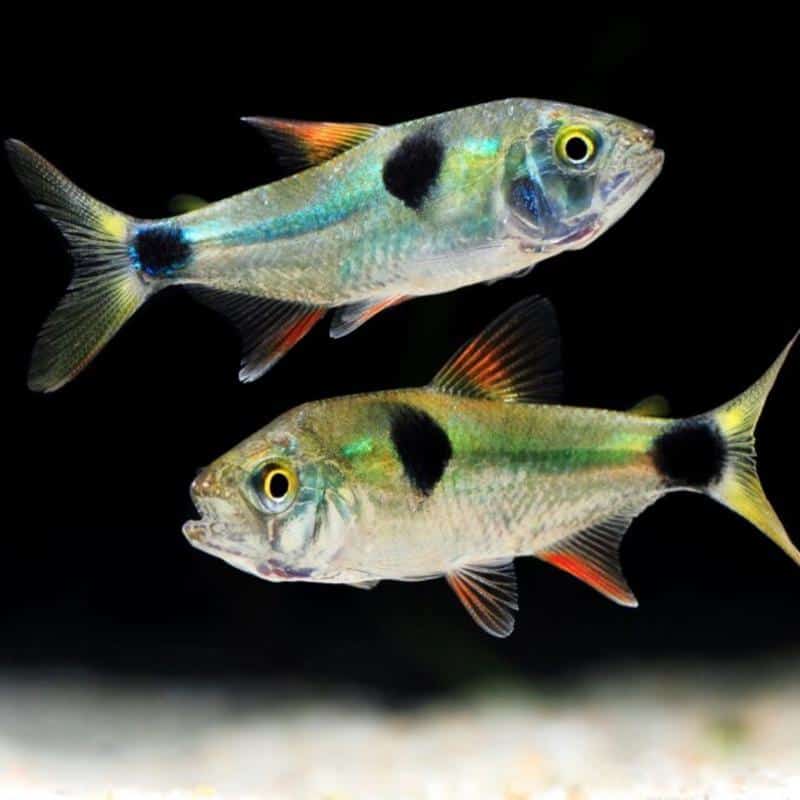
| Scientific Name | Exodon paradoxus |
| Average Size | 4 – 5 inches |
| Lifespan | 8 – 10 years |
| Minimum Tank Size | 35 gallons |
| Ideal Temperatures | 75 – 82 degrees Fahrenheit |
| Ideal pH Levels | 6.0 – 7.5 |
All tetras have a form of aggression to them, but none of them come close to the high aggression in the Bucktooth Tetra. This violent fish is best kept with seasonal aquarists than beginners due to its vicious nature characterized by scale-eating and ripping fish apart.
The best way to drastically reduce their aggression is to keep them in a large group of about 10 -12 tank mates. This ensures that no single tetra is targeted by another, which eventually encourages teamwork. Also, ensure to keep them in a single-species tank; they can easily kill bigger fish and are known to hunt down other vicious fish like the cichlids.
9. Green Spotted Puffer – Extremely Aggressive
| Common Names | Dwarf puffer, GSP |
| Scientific Name | Tetraodon nigroviridis |
| Average Size | Up to 6 inches |
| Lifespan | 5 – 8 years |
| Minimum Tank Size | 55 gallons |
| Ideal Temperatures | 75 – 82 degrees Fahrenheit |
| Ideal pH Levels | 7.3 –8.5 |
Green Spotted Puffer is the most aggressive pufferfish in the world, which is best kept alone in its own environment away from other fish. They are very ferocious at hunting their tankmates, and you will often have several deaths if you house GSP with other species.
They are more aggressive towards their own species; they nip at the fins of the fish and may attack or even kill the fish if they feel threatened or if they are hungry.
Green Spotted Pufferfish are also known for their strong jaw and ability to deliver a painful bite, which they may use to defend themselves or their territory.
10. Jaguar Cichlid – Extremely Aggressive
| Common Names | Managuense cichlid, managua cichid, spotted guapote, jaguar guapote, Aztec cichlid, guapote tigre. |
| Scientific Name | Parachromis managuensis |
| Average Size | 14 – 16 inches |
| Lifespan | 10 – 15 years |
| Minimum Tank Size | 70 gallons |
| Ideal Temperatures | 75 – 87 degrees Fahrenheit |
| Ideal pH Levels | 7.0 – 8.7 |
Jaguar cichlids are known for their bursts of aggression, and they can grow up to 2 feet in the wild, making them feisty beasts. They are as aggressive as the common Jack Dempsey, gaining more aggression with an increase in temperature and when the spawning season comes along.
They do not coexist peacefully with their own kind, and the only way to minimize aggression among the same species is to pair bond. It is advisable to raise them as a bonded pair or with a group of juveniles from an early age; thereby, when they mature, they will already have gotten used to each other’s company.
Other suitable tank mates for jaguar cichlids include Oscar, Jack Dempsey, Flowerhorn cichlid, Green terror cichlid, Bala shark, Sailfin pleco, as well as other large plecos, Blue Acara cichlid, Wolf cichlid, and Large catfish.
Also Read:
Conclusion
There are various signs of aggression that aquarists can look out for, including physical trauma, stress and bullying, same-sex territorial behavior, predatory behavior, and fish chasing other fish. These signs can help to differentiate natural behavior from aggressive behavior.
It is important to understand that different fish species exhibit aggression in different ways and that predatory fish should be kept separate from other fish.
By being aware of these signs of aggression, aquarists can take steps to minimize aggression in their aquariums, which ultimately leads to a healthy and peaceful environment for all fish.
